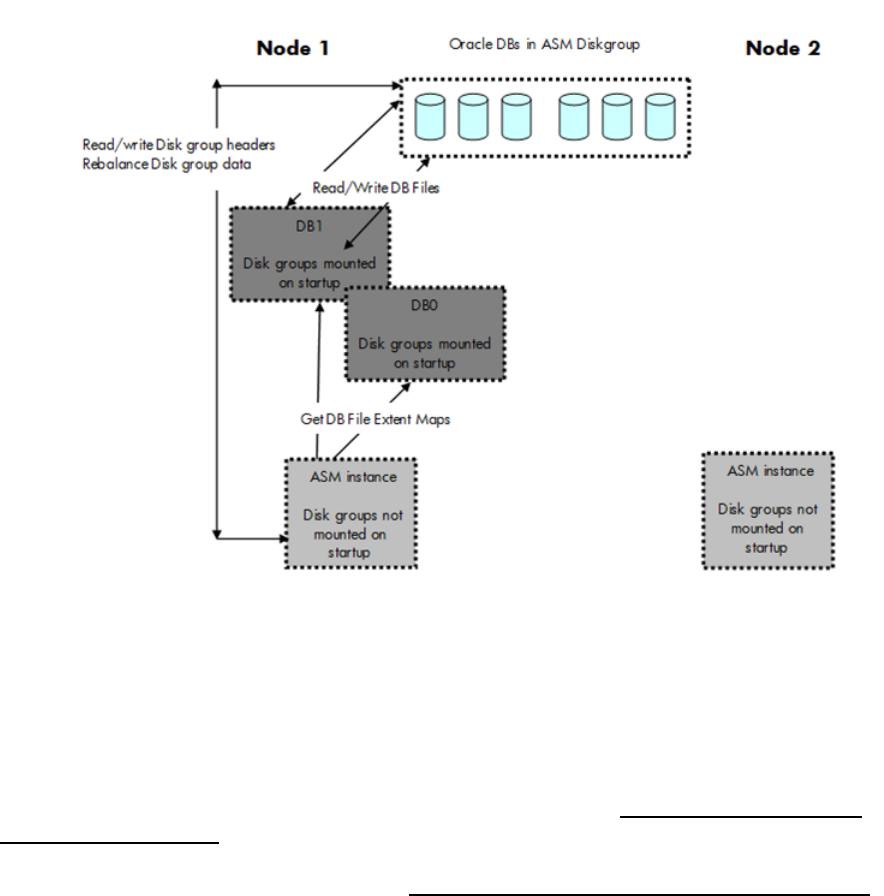HP Serviceguard Enterprise Cluster Master Toolkit User Guide (5900-2145, April 2013)
Table Of Contents
- HP Serviceguard Enterprise Cluster Master Toolkit User Guide
- Contents
- 1 Introduction
- 2 Using the Oracle Toolkit in an HP Serviceguard Cluster
- Overview
- Supported Versions
- Support for Oracle Database Without ASM
- Supporting Oracle ASM Instance and Oracle Database with ASM
- What is Automatic Storage Management (ASM)?
- Why ASM over LVM?
- Configuring LVM Volume Groups for ASM Disk Groups
- Sample command sequence for configuring LVM Volume Groups
- Serviceguard support for ASM on HP-UX 11i v3 onwards
- Framework for ASM support with Serviceguard
- Installing, Configuring, and Troubleshooting
- Setting up DB instance and ASM instance
- Setting up the Toolkit
- ASM Package Configuration Example
- Modifying a Legacy Database Package Using an Older Version of Oracle ECMT Scripts to use the Scripts Provided for ASM Support
- Adding the Package to the Cluster
- Node-specific Configuration
- Error Handling
- Network Configuration
- Database Maintenance
- Configuring and packaging Oracle single-instance database to co-exist with SGeRAC packages
- Configuring Oracle single-instance database that uses ASM in a Coexistence Environment
- Attributes newly added to ECMT Oracle toolkit
- Configuring a modular failover package for an Oracle database using ASM in a coexistence environment
- Configuring a legacy failover package for an Oracle database using ASM in a Coexistence Environment
- ECMT Oracle Toolkit Maintenance Mode
- Supporting EBS database Tier
- Oracle ASM Support for EBS DB Tier
- 3 Using the Sybase ASE Toolkit in a Serviceguard Cluster on HP-UX
- Overview
- Sybase Information
- Setting up the Application
- Setting up the Toolkit
- Sybase Package Configuration Example
- Creating the Serviceguard package using Modular method
- Adding the Package to the Cluster
- Node-specific Configuration
- Error-Handling
- Network configuration
- Database Maintenance
- Cluster Verification for Sybase ASE Toolkit
- 4 Using the DB2 Database Toolkit in a Serviceguard Cluster in HP-UX
- 5 Using MySQL Toolkit in a HP Serviceguard Cluster
- MySQL Package Configuration Overview
- Setting Up the Database Server Application
- Setting up MySQL with the Toolkit
- Package Configuration File and Control Script
- Creating Serviceguard Package Using Modular Method
- Applying the Configuration and Running the Package
- Database Maintenance
- Guidelines to Start Using MySQL Toolkit
- 6 Using an Apache Toolkit in a HP Serviceguard Cluster
- 7 Using Tomcat Toolkit in a HP Serviceguard Cluster
- Tomcat Package Configuration Overview
- Multiple Tomcat Instances Configuration
- Configuring the Tomcat Server with Serviceguard
- Setting up the Package
- Creating Serviceguard Package Using Modular Method
- Setting up the Toolkit
- Error Handling
- Tomcat Server Maintenance
- Configuring Apache Web Server with Tomcat in a Single Package
- 8 Using SAMBA Toolkit in a Serviceguard Cluster
- 9 Using HP Serviceguard Toolkit for EnterpriseDB PPAS in an HP Serviceguard Cluster
- 10 Support and Other resources
- 11 Acronyms and Abbreviations
- Index

Figure 4 ASM environment when DB1 fails on node 2
Serviceguard Toolkit Internal File Structure
HP provides a set of scripts for the framework proposed for ASM integration with Serviceguard.
The ECMT Oracle scripts contain the instance specific logic to start/stop/monitor both the ASM
and the database instance. These scripts support both legacy and the modular method of packaging.
HP recommends that you use the modular method of packaging, because the legacy method is no
longer approved and will not be supported in future. For more information on creating a modular
package, see latest Managing Serviceguard manual available at http://www.hp.com/go/
hpux-serviceguard-docs—>HP Serviceguard . Serviceguard provides tools to migrate existing
legacy packages to modular packages. For more information, see whitepaper “Migrating Packages
from Legacy to Modular Style” available at http://www.hp.com/go/hpux-serviceguard-docs-> HP
Serviceguard.
Legacy packages use the package configuration file and the package control script for the ASM
or database instance on the Serviceguard. The package configuration file parameters are stored
in the Serviceguard configuration database (CDB) at cmapplyconf time, and are used by the
package manager when it acts on behalf of this package. The control script invokes the ASM or
the database instance specific functions for start/stop/monitor through the toolkit interface script
(toolkit.sh). On the instance specific side, there is a toolkit configuration file (haoracle.conf) which
is sourced by the start/stop/monitor (haoracle.sh,haoracle_sql.sh, haoracle.mon,
and halistener.mon) script files. The toolkit interface script allows the start/stop/monitor calls
to remain unaffected by changes in the instance specific scripts. Figure 5, shows the internal file
structure for legacy packages.
Supporting Oracle ASM Instance and Oracle Database with ASM 37










